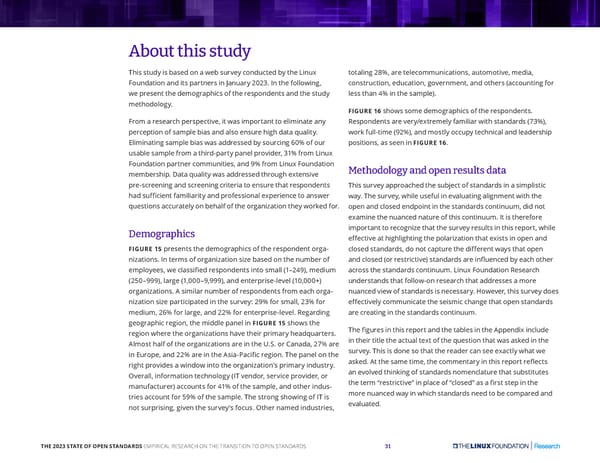About this study This study is based on a web survey conducted by the Linux totaling 28%, are telecommunications, automotive, media, Foundation and its partners in January 2023. In the following, construction, education, government, and others (accounting for we present the demographics of the respondents and the study less than 4% in the sample). methodology. FIGURE 16 shows some demographics of the respondents. From a research perspective, it was important to eliminate any Respondents are very/extremely familiar with standards (73%), perception of sample bias and also ensure high data quality. work full-time (92%), and mostly occupy technical and leadership FIGURE 16. Eliminating sample bias was addressed by sourcing 60% of our positions, as seen in usable sample from a third-party panel provider, 31% from Linux Foundation partner communities, and 9% from Linux Foundation Methodology and open results data membership. Data quality was addressed through extensive pre-screening and screening criteria to ensure that respondents This survey approached the subject of standards in a simplistic had sufficient familiarity and professional experience to answer way. The survey, while useful in evaluating alignment with the questions accurately on behalf of the organization they worked for. open and closed endpoint in the standards continuum, did not examine the nuanced nature of this continuum. It is therefore Demographics important to recognize that the survey results in this report, while effective at highlighting the polarization that exists in open and FIGURE 15 presents the demographics of the respondent orga- closed standards, do not capture the different ways that open nizations. In terms of organization size based on the number of and closed (or restrictive) standards are influenced by each other employees, we classified respondents into small (1–249), medium across the standards continuum. Linux Foundation Research (250–999), large (1,000–9,999), and enterprise-level (10,000+) understands that follow-on research that addresses a more organizations. A similar number of respondents from each orga- nuanced view of standards is necessary. However, this survey does nization size participated in the survey: 29% for small, 23% for effectively communicate the seismic change that open standards medium, 26% for large, and 22% for enterprise-level. Regarding are creating in the standards continuum. FIGURE 15 shows the geographic region, the middle panel in region where the organizations have their primary headquarters. The figures in this report and the tables in the Appendix include Almost half of the organizations are in the U.S. or Canada, 27% are in their title the actual text of the question that was asked in the in Europe, and 22% are in the Asia-Pacific region. The panel on the survey. This is done so that the reader can see exactly what we right provides a window into the organization’s primary industry. asked. At the same time, the commentary in this report reflects Overall, information technology (IT vendor, service provider, or an evolved thinking of standards nomenclature that substitutes manufacturer) accounts for 41% of the sample, and other indus- the term “restrictive” in place of “closed” as a first step in the tries account for 59% of the sample. The strong showing of IT is more nuanced way in which standards need to be compared and not surprising, given the survey’s focus. Other named industries, evaluated. THE 2023 STATE OF OPEN STANDARDS EMPIRICAL RESEARCH ON THE TRANSITION TO OPEN STANDARDS 31
 The 2023 State of Open Standards Page 30 Page 32
The 2023 State of Open Standards Page 30 Page 32